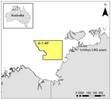A redundant former oil and gas offshore structure fabrication yard on the west coast of Scotland is to be reinstated as a dry dock.
Kishorn's drydock, one of the largest in Europe at 160m-diameter, built the 610,000-tonne, concrete Ninian complex support structure, among others, in the 1970s.
Work to reinstate the dry dock has already started with a contract awarded to Harris Pye, a Welsh marine engineering firm, to trial the dock gates, which were last opened when the Skye Bridge caissons were constructed there in 1993.
The contract includes the fabrication of a new set of gate seals and culvert tube covers, which, when installed, will allow the dry dock to be pumped dry for the first time in almost 25 years.
The dry dock is of such a size that it will take four days using six huge 12in pumps to empty it. Once the dock is emptied, it will allow inspection of the facility, ensuring that it can be re-used for a wide range of prospective contracts.
The two massive hollow concrete dock gates, each weighing in excess of 13,000-tonne, will also be pumped out to ensure that they can be floated to allow the movement of structures into the dry dock.
Kishorn Port (KPL), a joint venture between Ferguson Transport & Shipping and Leiths (Scotland), has been working hard over the last eight years to identify markets that need access to sheltered deep water, big lay down areas and a large dry dock.
To date this has included the offshore renewables industry which has a requirement for the serial production of large concrete structures. Kishorn, with its on-site quarry and concrete production facilities is attracting attention from this growth market.
Interest in the yard has also been expressed by oil and gas fabricators and latterly, the oil and gas decommissioning sector. Whilst the oil and gas industry in the North Sea is currently facing difficult times, there is an expanding requirement to decommission facilities that are at the end of their economic life.
The projected cost of decommissioning the North Sea oil and gas infrastructure has been estimated at £75 billion, says KPL, and continues to grow. To date, most of the large contracts have gone to yards elsewhere in Europe or Scandinavia, mainly because there is a shortage of adequate licensed facilities in Scotland, says KPL.
Alasdair Ferguson, a KPL Director said: “If Scotland is to capture a share of this market, it is essential to invest in and bring on stream sites such as Kishorn and make them 'decommissioning ready.'
Dry docks are ideal for decommissioning floating structures in a contained environment, particularly if they can be accessed by super heavy lift vessels that need sheltered deep water up to 38m in depth where 70m is available to tranship their loads.”
Proving and cycling the dry dock at Kishorn is just the first phase of its development. Licencing the yard for handling decommissioning projects is the next hurdle and consultation with the appropriate authorities has already started. Further development of its shore side facilities and infrastructure will be needed and Kishorn Port is actively seeking partners with decommissioning experience to work with KPL to take the yard forward into this exciting and expanding market.
The original Kishorn Yard was developed as a manufacturing and fabrication yard for oil platforms in the 1970’s. The yard was owned by Howard Doris and operated from 1975 to 1987. In 1975 work began on the North side of Loch Kishorn to develop a substantial acreage in order to build the Ninian Central Platform.



